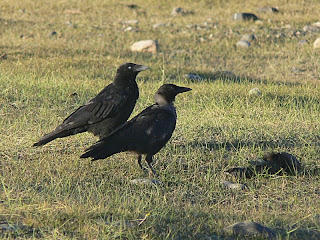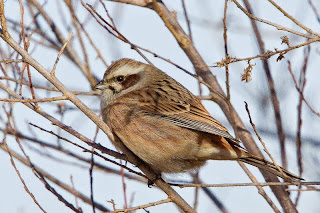First Birding 2015
text & photos by Abu
(© A. Buchheim)
Ice-art at the sewage stream. UB, Jan 2015
Unbelievably, it took me until 3 January to finally go birding, he he. Together with Nyambayar, Huyagaa and Amarkhuu, I went out to find a good spot, ideally filled with birds. This was in preparation for the Birdwatcher’s Weekend on 10 and 11 January to which already more than 90 individuals have signed in. This is an as impressive as well as unexpected high number and we hoped to find a spot with good numbers of birds!
Our search started in the area below Songino Khairkhan Uul at about 9:30 in the morning. It was quite chilly still, about minus 22°C (minus 7.6°F) and the wind had blown all the city smog down there.
After that we headed for the Medical Botanical Garden a few km west of Songino village. Here, a small plantation of Sea Buckthorn attracted more than a hundred Bohemian Waxwings which were quite approachable. We also checked a patch of riparian forest west of what is called “UB bird plant” and finally tried to check out the UB Ponds. Thanks to seemingly uncontrolled and excessive occupation of the land we could not make it there before it got too late.
I have included some appetizing shots here, nothing special, though. For the waxwings and redpolls you may also check these posts (Bohemian Rhapsody, redpoll ID).
Male White-backed Woodpecker
below Songino Khairkhan Uul, UB, Jan 2015
Male White-backed Woodpecker
below Songino Khairkhan Uul, UB, Jan 2015
Bird List (32 species)
Ruddy Shelduck - c10
Common Pochard - 1 male was an addition to my UB winter list
Common Goldeneye - 8 on the sewage stream
Daurian Partridge 1 - flushed at the Med. Bot. Gardens
Common Kestrel - 2
Rock Dove - present
Eurasian Collared Dove - 2 near the “bird plant”
White-backed Woodpecker - 2
Lesser Spotted Woodpecker - 2
Mongolian Horned Lark - several hundred in the field around Med. Bot. Gardens
Mongolian Lark - several hundred in the fields
Male Lesser Spotted Woodpecker
Med. Bot.Gardens, UB, Jan 2015
Target: berries for the waxwings
Med. Bot.Gardens, UB, Jan 2015
Male Bohemian Waxwing
Med. Bot.Gardens, UB, Jan 2015
1st winter female Bohemian Waxwing picking a berry
Med. Bot.Gardens, UB, Jan 2015
Another 1st winter female Bohemian Waxwing
Med. Bot.Gardens, UB, Jan 2015
She preferred “square” berries
Med. Bot.Gardens, UB, Jan 2015
Portrait of a male Bohemian Waxwing
Med. Bot.Gardens, UB, Jan 2015
Portrait of another male Bohemian Waxwing
Med. Bot.Gardens, UB, Jan 2015
Portrait of a female Bohemian Waxwing
Med. Bot.Gardens, UB, Jan 2015
Bohemian Waxwing – only 50 below Songino Khairkhan Uul but 150 at Med. Bot. Gardens
Red-throated Thrush - 1 only
Great Tit - a few at each location
Azure Tit - 3
Willow Tit - 2
Eurasian Nuthatch - 2
Asian Azure-winged Magpie - c30 below Songino Khairkhan Uul
Eurasian Magpie - present
Daurian Jackdaw - 4 below Songino Khairkhan Uul
Eastern Rook (pastinator) - 6
Oriental (Carrion) Crow (orientalis)- present
Common Raven - present
House Sparrow - present
Eurasian Tree Sparrow - present
Chaffinch - 1 female below Sonigon Khairkhan Uul
Brambling - 1
"Pale Mountain" Twite - 3
Mealy Redpoll - c25 below Songino Khairkhan Uul
Hawfinch - c15
Long-tailed Rosefinch - a pair below Songino Khairkhan Uul
Meadow Bunting - c10
Male Mealy Redpoll
below Songino Khairkhan Uul, UB, Jan 2015
Male Mealy Redpoll
below Songino Khairkhan Uul, UB, Jan 2015
Male Mealy Redpoll
below Songino Khairkhan Uul, UB, Jan 2015
Female Mealy Redpoll
below Songino Khairkhan Uul, UB, Jan 2015
Female Mealy Redpoll dropping foodparts
below Songino Khairkhan Uul, UB, Jan 2015

























































